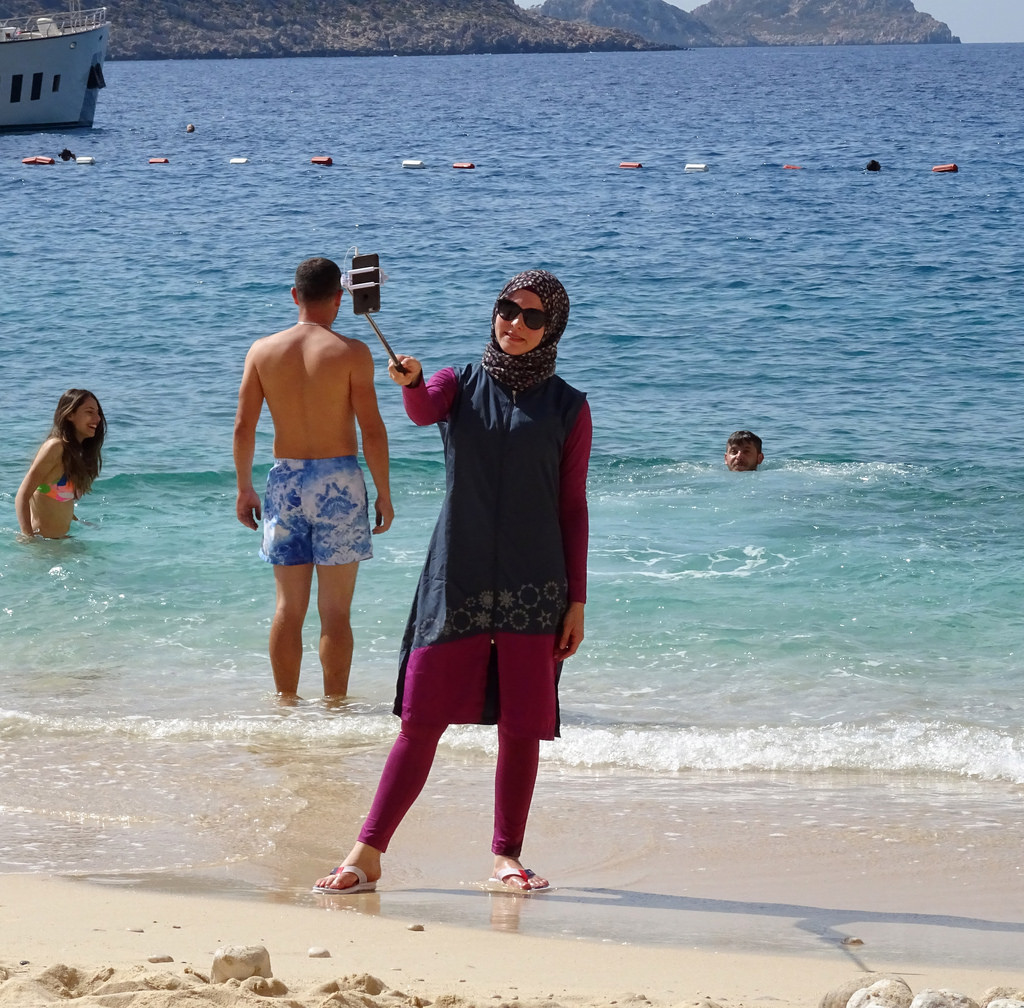“Burkini debate – undressing the meaning”
October 28th, 2016 The debate over the burkini has divided the left and right, but Will Nicholl, 23, a Correspondent in London, UK, frames the symbolic meaning of women’s clothing in the wider debate of power and control.
The debate over the burkini has divided the left and right, but Will Nicholl, 23, a Correspondent in London, UK, frames the symbolic meaning of women’s clothing in the wider debate of power and control.
As the debate surrounding the burkini continues, both left and right repeatedly fail to deconstruct the issue. The burkini argument needs to be separated into two debates: the first is about what women can and cannot wear, and the second is about what what they wear ‘does’.
Let’s tackle the first debate. Women can wear whatever they want.
Moving on to the second debate, the issue with the burkini is that it is inherently patriarchal. Although it is easy to be drawn into a narrative that avoids the controversial, the semiotics behind religious clothing cannot simply be ignored in order to further liberal arguments.
Those of us on the left have to accept that most, if not all religious clothing comes with some level of symbolic meaning. This symbolic meaning, because of its religious parentage, is in turn likely to have a patriarchal root.
Before analysing the semiotics of the burkini, it is important to take a long introspective look at our own standards. The media demands certain “norms” of women’s bodies. It chastises them for non-conformance, with the punishment often being verbal abuse and sometimes sexual assault. The sexualisation of the female body is a crucial element of control. That the flesh has been so successfully dominated by men for the last two millennia is without question the greatest (and gravest) success story of soft power.
Through this sexualisation, women’s position in society is constantly undermined. All of this matters because it ties into a wider and more important question about what the flesh means. Through controlling what women’s bodies represent, men the world over have achieved an unprecedented level of dominance. The “Free the Nipple Campaign” is one striking example of an attempt to undermine this. By making the mysterious mundane, the campaign seeks to move women’s bodies in line with men’s.
The burkini is representative of this same control. The mistake that mainstream media has made is to contrast the burkini with the bikini. In the mainstream narrative, the burkini is symbolic of Islamic culture’s repression of women, whilst the bikini is symbolic of Western liberalism. In reality they achieve very similar outcomes (if anything the bikini is more controlling garment). Both carry with them exogenous forms of control on their wearer. The bikini demands the flesh be a certain size and shape, whereas the burkini demands it be mysterious.
The outcome of both forms of control is the same: that a patriarchal narrative decides what women’s bodies will “mean”. In the case of the burkini (and Islam) it will be mysterious, in the case of the bikini (and the West) it will be sexual. Neither outcome provides any real emancipatory effect.
Despite the left’s existential turmoil about how to see the burkini (and their eventual decision to settle on the notion that it is somehow liberating), it is important to see it as oppressive. Simply because Wahhabism in Saudi Arabia bans women from bathing on public beaches does not suddenly make any bathing in and of itself liberal. The burkini is a means of retaining, from afar, a form of structural dominance. In response to the argument that it allows Muslim women to enjoy the beach like anyone else, one must ask “what does covering the flesh mean and do?”.
In sociology, “emergent systems theory” explains how tiny changes in behaviour, though seemingly insignificant, can create cultures which are greater than the sum of their parts. While no piece of clothing alone can define an individual, through the inter-subjective meaning we attach to these items and their mass use, they can come to have great influence psychologically and politically.
As I said above, women should wear what they want, however the point is that what we wear has profound consequences. Symbols shape behaviour, behaviour shapes cultures, and if behaviours are rooted in inequality then the cultures formed will be, too. Through its symbolism the burkini intensifies the reach and power of an oppressive ideology. The same, to all intents and purposes, goes for the bikini. For that matter, this also applies to women’s sportswear and office wear.
Women should be allowed to wear the burkini if they want to, but there should also be greater focus on the semiotics behind clothing generally. If the ability to bathe comes at the cost of perpetuating structures which ultimately undermine women, then rather than removing their ability to bathe, the government should seek to question those structures.
More space for Muslim voices in shaping public discussion would be welcome. Although the media has entangled itself trying to answer whether clothing that is indicative of a patriarchal religion should be allowed, there is in fact a very simple answer. Wear what you want, but know what what you wear ‘does’.
Photo credit: chericbaker Kaputas burkini selfie via photopin (license)
…………………………………………………………………………………………………………………
About me: I am a masters student studying Gender, Globalisation and Development at the LSE. My ambition is to work in policy design at an international institution such as the UN. My interests revolve around understanding how people come to think about one another and using that knowledge to improve the ways in which we deal with and communicate with others. My current work looks at development policy and improving the ways in which charities help those in need.
…………………………………………………………………………………………………………………
Opinions expressed in this article are those of the author and do not necessarily represent the views of the Commonwealth Youth Programme. Articles are published in a spirit of dialogue, respect and understanding. If you disagree, why not submit a response?
To learn more about becoming a Commonwealth Correspondent please visit: http://www.yourcommonwealth.org/submit-articles/
…………………………………………………………………………………………………………………




